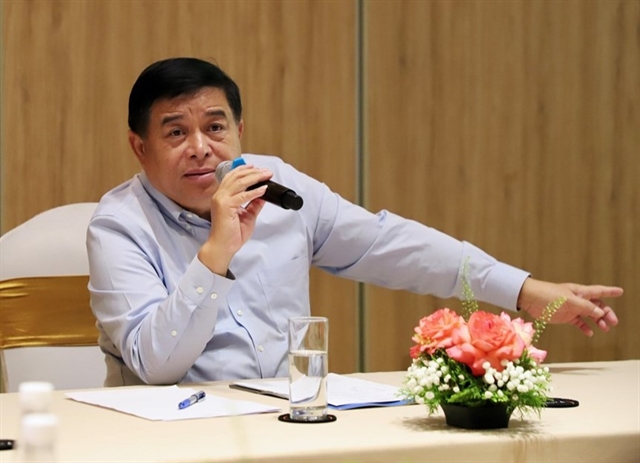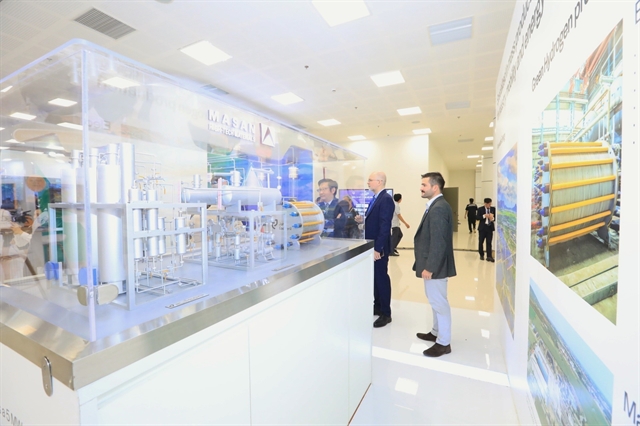 Opinion
Opinion

 |
| Minister of Planning and Investment Nguyễn Chí Dũng. — Photo courtesy of the Ministry of Planning and Investment |
Minister of Planning and Investment Nguyễn Chí Dũng spoke to the press about the development of the National Innovation Centre and its role in Việt Nam’s strategies to promote science, technology and innovation.
How was the National Innovation Centre (NIC) established?
The NIC was established during the time when we were assigned to research and advise the Party and the State on socio-economic development strategies for the 10-year period from 2021 to 2030. This includes the ambitious goals for the country’s development in 2030-2045.
By 2030, Việt Nam must become a developing country with upper-middle income and modern industries, and by 2045, the country is set to be a high-income developed country. Therefore, our time resources are limited. Meanwhile, Industry 4.0 continues at a rapid rate. To reach those goals and overcome the challenges to achieve such ambitions, what should be the growth drivers for Việt Nam?
The Ministry of Planning and Investment (MPI) has conducted research and determined that science, technology and innovation remain at the core of growth. The MPI advised the Party to include this point in the Resolution of the 13th National Party Congress, and to consider this a strategic breakthrough in terms of institution, infrastructure and human resources. In alignment with this direction, preparations for the 14th National Party Congress are also underway for a new era of growth for Việt Nam.
I believe that science, technology and innovation must drive breakthroughs for development. Only in this way can Việt Nam take advantage of Industry 4.0 opportunities to generate exponential, sustainable progress, and reduce the development gaps with other countries. There is no other way and no other chance. Việt Nam has to grasp this rare opportunity.
Pursuing this direction, the MPI devised an urgent plan to establish a modern, cohesive, world-class national centre for innovation to nurture an innovation ecosystem that can promote science and technology research, create impacts and bring Việt Nam’s economy to new heights on the value chain.
Based on the Party Central Committee’s resolution, the MPI also looked into case studies from other countries and worked with world-leading consulting agencies on the establishment of the NIC. The project was well-received by ministries, sectors as well as local and international businesses. The Prime Minister approved the establishment of the centre on October 2, 2019.
What are the key highlights of the NIC in connecting different components of the innovation ecosystem?
In recent years, Việt Nam’s innovation has been highly regarded by the international community. Innovation has never seen such great attention and support for growth from the Government, ministries and sectors.
The NIC was established in a challenging context. Innovation requires specific and competitive policies. Accordingly, the MPI proposed the Government issue a dedicated decree regulating the centre’s operation, allowing specific priority and support.
The NIC has overcome multiple challenges in the past five years with the assistance of the Government, the Prime Minister and other ministries and sectors. Initial policies for general innovation have taken shape, and the Ministry of Science and Technology is taking over this progress. The MPI has also included various clauses on this matter in the Law on the Capital and Decree No 94/2020/NĐ-CP, which stipulates preferential mechanisms and policies for the NIC (currently being revised).
In terms of infrastructure, NIC has two facilities: a building on Tôn Thất Thuyết Street, whose effective operation has made its name as one of the most excellent centres in Việt Nam today, and the large-scale complex in Hòa Lạc, with support from foreign funding. The latter is setting the foundation for nine high-priority technology industries. The complex was named Best Commercial Building Architecture Design by the Singapore-based Asia Architecture Design Awards in 2024.
NIC has an unprecedented and substantial workload, which includes forming policies, facilities and structures. The most important thing is that NIC completes its tasks in parallel rather than sequentially. When its facilities were under construction, the centre also hosted various innovation activities, including conferences and seminars, as well as consulting, incubating and supporting start-ups, in addition to organising forums for investment funds, and particularly assisting businesses.
Hundreds of businesses of all scales and sizes have benefited from the centre, especially in terms of digital transformation support. NIC has accomplished a huge amount of work in a short time, but this is only the beginning and great challenges remain ahead. It must become a modern and world-class centre, establish connections with other facilities in the country and abroad, and be the point of connection between the Government and businesses, institutes and education institutions in research, technology transfer, product commercialisation and more. It must become a regional centre, making Việt Nam a destination for regional and global innovation.
That is the vision and ambition that NIC is working towards every hour of every day. Its immediate goal is to form the nine high-priority technology industries. This is a huge challenge that requires tremendous effort, but it will help Việt Nam take advantage of even the smallest opportunities in Industry 4.0 and innovation for the country.
 |
| Innovation products on display as part of the Việt Nam International Innovation Expo 2023 at the National Innovation Centre (NIC) in Hòa Lạc Hi-tech Park. — VNA/VNS Photo Tuấn Anh |
What are the specific policies for innovation that Việt Nam has developed in recent years?
Support for start-ups stands out among NIC’s policies. Start-ups receive consulting and assistance in accessing resources, funding and more to help them understand the demands of businesses and localities, as well as the ability of the start-ups or other stakeholders in the ecosystem to address these needs. This helps form connections and provides support to localities and businesses to solve their problems.
Developing breakthrough mechanisms is a common bottleneck, and this will be given priority for resolution at the NIC. We have the facilities but cannot make decisions on leasing, trading, partnering or lending. Current procedures are quite complicated due to various regulations in public asset management law.
The MPI has reported to the Government and submitted to the National Assembly a proposal that the Law on Capital allow the NIC to make independent decisions regarding the use of its infrastructure, without needing to follow current procedures. This will allow the NIC a more active role to manage its assets with flexibility and efficiency.
What are Việt Nam’s immediate plans and strategies to promote innovation and particularly the NIC?
The first task is to develop a comprehensive and cohesive mechanism for optimal operations according to international standards.
The second task is to complete construction of facilities, including research centres, labs and accommodation for experts.
The third task is to rapidly establish the nine high-priority technology industries, including smart production, smart city, digital communications, cybersecurity, environment, healthcare semiconductors, hydrogen and more. The MPI is focusing its efforts on research and training centres, especially in regard to semiconductors.
The NIC will soon take on an important task, which is to manage the training programme for workers in the semiconductor industry. This is an ambitious and strategic goal that aims to train at least 50,000 semiconductor engineers for the Vietnamese and possibly foreign markets from now until 2050, seizing the opportunity at hand.
People are our best resource, and we must fully tap into this potential. Without proper training, we will not have the skilled workforce needed to meet requirements. The demand is enormous, and our workers are ready. We can train them and trust that the NIC will quickly emerge as a pioneer in the global semiconductor value chain. — VNS




